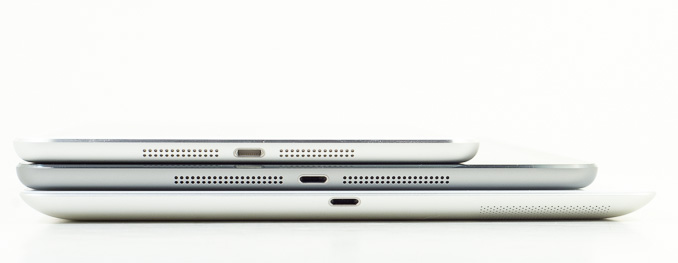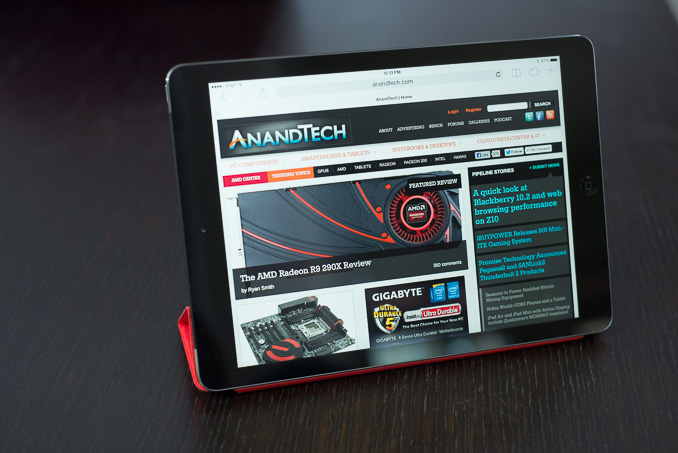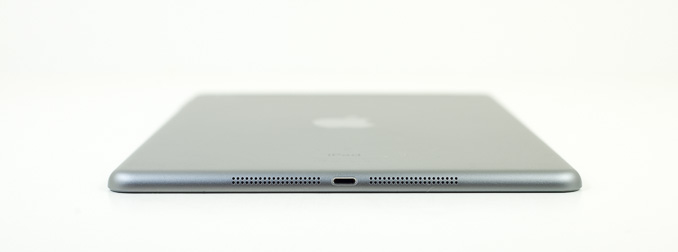The iPad Air Review
by Anand Lal Shimpi on October 29, 2013 9:00 PM ESTFinal Words
Two weeks ago I had all but written off the bigger iPad. It was too bulky and just no where near as portable as the iPad mini. Once the latter gets a Retina Display and equal hardware across the board, why would anyone consider the bigger model?
The iPad Air changed my perspective on all of that. It really does modernize the big iPad. While I suspect there are still going to be a lot of users who prefer the smaller form factor of the iPad mini with Retina Display, I do feel like there are those users who will continue to appreciate all of the benefits that go along with having a larger display. Text is easier to read, particularly on desktop versions of websites. Photos and videos are larger and thus more engaging as well. In the past there was this complex matrix of tradeoffs that you had to make between iPad and iPad mini. This generation, Apple does away with all of that.
All you need to do is pick your screen size. If you prefer the 9.7-inch form factor of the original iPad, the Air gets you as close as possible to a mini without giving up that display size.

From top to bottom: iPad mini, iPad Air, iPad 4
The name does the product justice in this case. In two hands or lightly propped up against something (palm, legs, chest), the iPad Air feels incredibly light - the weight just seems to disappear. The larger chassis doesn’t feel very dense at all. The in-hand feel of the device is really unlike any other iPad. It feels like a lightweight slate, rather than a heavy computing device. This is the iPad that Apple likely wanted to launch on day 1, it just took a bit over three years to get here.
Build and material quality are of course excellent. The iPad Air borrows much of the design language from the iPad mini, and makes the transition to a larger display quite nicely. The Air ends up looking a lot more modern than its predecessor.
Despite making the transition to a thinner touch and display stack, the iPad Air’s display is every bit as good as previous Retina Display iterations. Color accuracy remains best in class, delivering an out of box display experience that’s better than most systems, even at substantially higher price points. The only thing that the iPad Air leaves me wanting on the display front is a lower reflectance stack. Laminating the cover glass to the LCD panel is something that Apple does on both the iPhone and iMac, it’s time that the same feature is brought down to the iPad.
Apple’s decision to unify silicon across the iPhone 5s, iPad Air and iPad mini with Retina Display is an interesting one, but ultimately it doesn’t come with any real tradeoffs for iPad owners. Apple’s own 64-bit Cyclone cores are incredibly powerful, even more so than I originally expected when I reviewed the iPhone 5s. Apple seems to have built a bigger, higher performance CPU architecture than any other ARM player, including ARM itself. The design isn’t perfect, but it’s a completely different caliber performer than anything else it competes against. As such, Apple was completely justified in putting the A7 in both the iPhone 5s and the iPad Air. If anything, I’d argue that it might be overkill for the 5s given the device’s smaller battery, but my sensibilities soon get the best of me and remind me that more performance on tap is never a bad thing.
On the GPU front, Apple does increase performance over the iPad 4 as well - despite having a narrower memory bus. The increase in performance ranges from 40 - 70% depending on workload. I suspect we’re beginning to see some of the limits of 28nm here as Apple would’ve traditionally gone for an even larger GPU.
Despite having a smaller/thinner/lighter battery, battery life improves across the board compared to the 3rd and 4th generation iPads. Battery life in our web browsing, video playback and gaming workloads is better than either of the previous two iPads. Only the iPad 2,4 was able to deliver better battery life, but nothing with a Retina Display can match the iPad.
Cellular integration remains awesome on the iPad Air. With a single SKU covering 34 countries and no network operator lock, at least for those devices sold in the US, the LTE iPad Air is amazingly flexible from a network portability standpoint.
Improvements around the edges are nice as well. The inclusion of a second microphone can improve FaceTime HD calls in noisy environments, and faster WiFi is a nice addition.
My only complaints are limited to iOS 7, memory size and pricing. It’s clear that even on the fastest hardware Apple has to offer, iOS 7 isn’t always super smooth (particularly when using multitasking gestures to switch between apps) on an ultra high resolution device. The move to a 64-bit OS and applications makes a lot of sense, but with no corresponding increase in DRAM size Apple creates additional memory pressure on all of the A7 enabled devices. Finally, I’d love to see Apple update the default iPad configurations. Although 16GB is fine for a device that’s not going to be storing a ton of photos/videos locally, it would really be nice to get at least 32GB on the entry level iPad. The first complaint I suspect will be addressed over time. The second is a reality we just have to live with unfortunately, and the third won’t change until market dynamics force it to.
The iPad Air is the most significant upgrade to the 9.7-inch iPad in its history. It’s lighter, more portable, more usable and faster than any previous iPad. It doesn’t fundamentally change what you can do with a tablet, but if you’re in the market for one the iPad Air really is the best iPad to date. Competition is definitely more stiff among the smaller tablets thanks to the Nexus 7, but in the nearly 10-inch tablet space it seems like Apple is going to continue to enjoy a great position there.












444 Comments
View All Comments
StigtriX - Tuesday, November 12, 2013 - link
Actually, the new Kindle 8.9 has at least as good a display as the iPad Air, if not better:"Amazon’s always touted the displays on its tablets, and the screen it’s using on the HDX 8.9 is a doozy. At a ridiculous 2560 x 1600-pixel resolution and 339ppi, it’s either higher-resolution or more pixel-dense than virtually any other tablet on the market. It also has great viewing angles, excellent color reproduction, and high brightness levels. It’s really just a great screen, whether you’re gaming, watching video, or reading text — it’s right up there with, if not better than, the Retina display on the iPad Air."
- The Verge
"While the speakers feel like something of an afterthought, Amazon is clearly waging a battle on the display front. The company keeps upping its game, and indeed, the screen here dazzles, with 2,560 x 1,600 resolution and a pixel density of 339 pixels per inch. That's a big jump up from the HD 8.9's 1,920 x 1,200 display, not to mention the new HDX 7-inch tablet, which has a 1,920 x 1,200 screen. It's even enough to make the iPad Air's 2,048 x 1,536 resolution (264 ppi) seem modest. It's simply a gorgeous thing to behold, making movie watching a downright pleasure. Heck, it even managed to make Sharknado look pretty good, which is no small feat. All in all, images are sharp, the level of detail is impressive and the colors are vibrant."
- Engadget
But, I do agree with you that too many let their personal opinions colour their reading of reviews. I prefer Android and PC, but I have an iPad and have tried several Macs. Even though I prefer other units, there is no point in denying the excellent quality and style Apple products come with. They, like Nintendo, only release products "when they are done" - no rushing.
MassiveTurboLag - Tuesday, October 29, 2013 - link
Really? You clearly never looked over one of their Android phone reviews. They are stupidly detailed.dsumanik - Wednesday, October 30, 2013 - link
Read this review with a grain of salt. Anand lai shimpi is heavenly vested in apple stock, doing everything he can to boost the dismal situation.Thinner bezels and light weight do not hide the fact that functionally, this iPad is the same as the previous 2 generations.
Sent from my ipad3, which will be upgraded when apple actually updates the product line.
Here's some basic ideas mr cook:
Wireless charging
Fingerprint scanner
Thunderbolt sync or usb3
Haptic feedback
NFC
Solon - Wednesday, October 30, 2013 - link
Wireless charging - deeply inefficient charging; maybe 50% of energy is actually picked up by the deviceFingerprint scanner - probably getting one next gen
Thunderbolt sync or USB3 - maybe; and it is possible the hardware already can do this; but Thunderbolt (a PCI-E spec) will never happen
Haptic feedback - dead concept; no one actually wants this; RIM failed at haptic
NFS - in a tablet? and is NFC actually used? No, it isn't.
dishayu - Wednesday, October 30, 2013 - link
Agree with your wireless charging argument, but that limits you from charging your iDevice if you don't have your own cable. All android phones use microusb, so it's not hard to find one at all (speaking of the real world here). Apple chose not to afford themselves that luxury.Fingerprint scanner : Although I think it's a gimmick and useless for the masses (almost everyone except from corporate users), they could have done it now, since they already have it in 5s. Why wait till next gen?
Haptic feedback : You probably would have said the same about touchscreens around 2005. I tried staying away from smartphones altogether until the Xperia Pro because there were no decent phone with a proper keyboard. After that I finally gave in an bought the HTC One and I still really miss my physical buttons. Haptic feedback could cure that.
NFC : I use it as much as I use Bluetooth (which is to say not a whole lot but a very handy feature still and I'd like to have it)
ws3 - Tuesday, October 29, 2013 - link
Yeah. Anyone who wanted to be truly objective would stopping running all of those tests that the iPad Air does so well in. If you want to be truly balanced, you have to run a bunch of tests that the iPad sucks at too, like maybe an .apk loading test or a malware running test.zeagus - Wednesday, October 30, 2013 - link
+lulzKoolAidMan1 - Wednesday, October 30, 2013 - link
Perfectpdjblum - Thursday, October 31, 2013 - link
Anand himself has stated where his loyalties lie: He said during a podcast that his advertisers were the motivating force behind the change in the look of the website. Obviously he is a slave to his advertisers who obviously want as much crApple content on the site as possible; of course they want it be overwhelmingly positive. This crApple model generates tons of hits for theverge and it does the same for anandtech.markthema3 - Monday, November 4, 2013 - link
He changed the layout of the site to better place the advertisments on the page. That's not catering to an individual company. The conclusion that he is therefore a slave to the advertisers is unfounded.